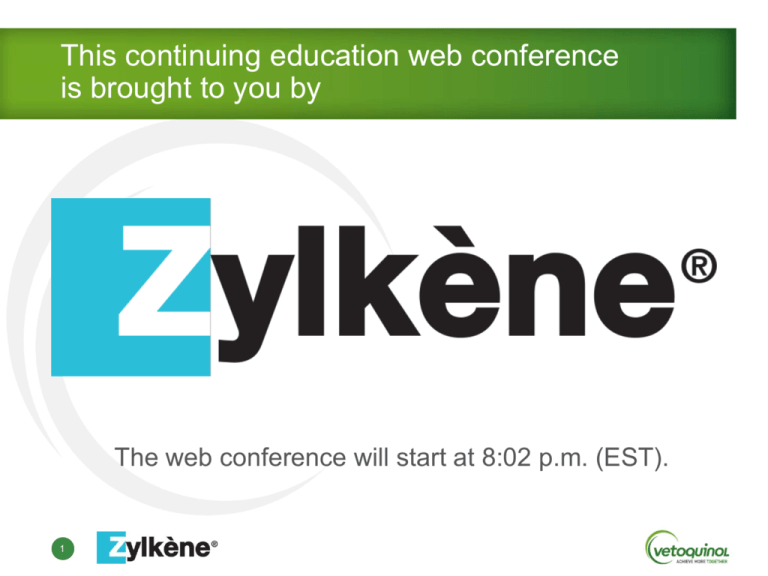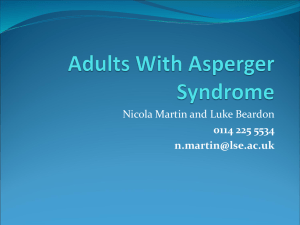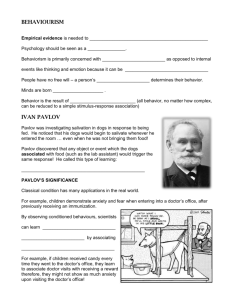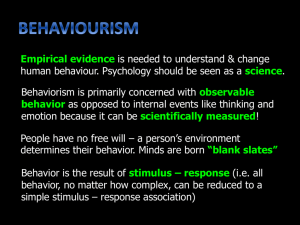Video
advertisement

This continuing education web conference is brought to you by The web conference will start at 8:02 p.m. (EST). 1 How Stress Affects Health and Behaviour; Strategies for Prevention and Treatment G. M. Landsberg DVM, DACVB, Dip. ECVBM-CA North Toronto Animal Clinic, northtorontovets.com CanCog Technologies, Director Veterinary Affairs 2 Presentation Outline • Diagnostic dilemma: «behaviour» or «medical»? • Normal vs. abnormal behaviour • Fear prevention & enrichment • Integrated approach to common stress-related behaviour problems Behaviour modification program Natural products and drugs • Case study • Question period 3 Veterinarian’s Role • Assess behaviour at each visit • Maintain health, welfare, bond • Behavior – may be first or only sign of medical issue Central nervous system (CNS), metabolic, cognitive dysfunction syndrome (CDS), sensory, Pain • Welfare (5 freedoms) expression of normal behaviour freedom from fear, discomfort, pain, hunger • Veterinarian’s role to prevent, diagnose, treat • Do the pet a favour ► ask about behaviour 4 Diagnostic Dilemma: Is it «Behaviour» or is it «Medical»? • Medical: Behaviour Signs • Stress: Effects on health / behaviour • Behaviour: Normal vs. Abnormal / Pathological • Combined 5 Medical Causing Behavioural • Neurologic / Central / Peripheral / CDS • Internal medicine Endocrine – increase / decrease (e.g. thyroid) Metabolic (e.g. encephalopathy) • Pain / welfare: Behavioural change, mobility • Sensory: Response to stimuli • Dermatology (e.g. self – trauma) • Drug effects (e.g. steroids / irritability) 6 Stress • Altered homeostasis: Affects health and behaviour Endocrine, immune, psychological • Hypothalamic-pituitary-adrenal axis (cortisol) acute / chronic effects on behaviour health • Noradrenergic system Acute / chronic sympathetic arousal – lack conscious control • Prolactin: Lower in acute stress, higher in chronic • Hyperglycemia with stress in cats • Opioid / beta-endorphin 7 Stress Effects on Medical Health • Acute vs. chronic effects • Chronic Immune: Increased sensitivity to pathogens Oxidative damage: stress, disease, age, drugs • Stress related diseases in human / dogs / cats GI, urinary, dermatologic, respiratory, aging Feline example: stressful events and skin, GI / appetite, urinary, respiratory, avoidance (Stella et al, JAVMA) 8 Stress: Ingestive and GI Signs • Humans Alter bacterial flora, gastric emptying, heartburn, colonic activity, intestinal permeability, irritable bowel, ulcerative colitis • Pets Anorexia (particularly problematic in some cats) gastrointestinal signs / colitis psychogenic polydypsia pica (lick, suck, gulp, gorge, coprophagia) obesity 9 Is it «Medical» or is it «Behavioural»? • Environmental licking n = 20 (Frank et al, ACVIM 2009) Full workup including GI, scope, biopsy GI disorders 14/20 dogs / resolved 10 of 18 10 Video: LICK3 11 Video: CAT01 12 Stress and the Urinary Health • Feline Interstitial Cystitis (FIC) and stress Altered bladder permeability, noradrenaline ↑ • MEMO (multi-modal environmental modification) reduce FIC, respiratory, fear, nervous, IBD, aggression (www.indoorpet.osu.edu) • Feliway diffuser – less bouts 13 Stress and the Urinary Health • FIC – Seawright et al., Cameron et al. Higher risk with recent move, recent injury, dogs in home, movement restricted by other cat Improvement over placebo by reducing anxiety, increasing space, separating resources 14 Stress and Dermatology • Brain-skin connection • Stress may be a trigger for skin disease • Psycho-neuro-immuno-endocrinological response • Human Stress and atopic dermatitis, psoriasis, urticaria Stress increase cytokines, IgE, eosinophils, vasoactive peptides in atopic vs. non-atopic Stress and increased epidermal permeability 15 Stress and Dermatology • Pets Increased severity and frequency of skin disorders in separation anxiety, non-social fear Psychogenic and recurrent pyoderma in dogs Psychogenic and pruritus in dogs Allergen penetration if increased permeability? 16 Stress and Mental Health • Enrichment, behavioural needs / time budget • Undesirable may fill void 17 Stress and Mental Health • Conflict: Competing motivation • Frustration: Unable to achieve goal • Displacement: Lick, circle, yawn, suck, drink 18 Video: GREETCIRCLE 19 Video: CIMG6542 20 Contributing Factors • Medical complications • Owner response 21 Stress and Mental Health • Recurrent / Chronic stress Cope vs. unable to achieve homeostasis 22 Stress and Mental Health • Correlates to humans phobia, generalized anxiety disorder, compulsive behaviour post traumatic stress, impulsivity, panic 23 Behaviour Pathology • Deprivation: Prenatal / neonatal / maternal • Insufficient early socialization / habituation • Genetics Abnormal serotonin and aggression English Cocker Spaniel, Springer Spaniel Compulsive – outside situations of conflict Repetitive, exaggerated, sustained Attention to particular goal Self-trauma, neurologic, ingestive 24 Compulsive Behaviour Doberman exhibiting obsessive flank-sucking. Photo: Tufts University. 25 Video: P1000025 26 Is it «Behavioural» or «Medical»? 27 Evaluation of 21 Cats with a Presumptive Diagnosis of Psychogenic Alopecia • Non-seasonal, no primary lesions, no scratch • Exam, blood / urine, derm assessment • Revolution (3 tx), food (Feline z/d - 8 weeks) Response assessed – food challenge if improved • Methylprednisolone acetate at 8 / 11 weeks Response to therapy assessed S. E. Waisglass, G. M. Landsberg , J.A. Yager, J. A. Hall, JAVMA 2006 28 Polling question Of the 21 cats referred with psychogenic alopecia, how many had an entirely medical cause? • • • • • 29 0 4 8 16 21 Results • Medical: 16/21 (76.2%) Food 57% / Multifactorial 52% • Psychogenic + Medical: 3/21 (14.3%) • Psychogenic alopecia (PA): 2/21 (9.5%) • Histology not confirmatory 30 Diagnosis - Behaviour Problems • Normal? Inappropriate / undesirable: Time / place / target No drugs indicated but natural products may help • Abnormal? Fear / anxiety, attention deficit, hyperactivity disorder (ADHD), panic, phobia, compulsive Rule out medical Drugs and/or natural products are indicated 31 Feline Behaviour • Normal behaviour Eliminate /mark Climb / explore Scratching Play / nocturnal Vocalize Predation Mating 32 • Common problems Eliminate /mark Climb / explore Scratching Play / nocturnal Vocalize Predation Mating (neuter) Canine Behaviour • Normal behaviour Age, breed, Individual Hunt / scavenge Eliminate / mark Social / object play Territorial – vocal Sexual 33 • Common problems Eliminate /mark Climb / explore Scratching Play / nocturnal Vocalize Predation Mating (neuter) Fear, Anxiety, Stress • Fear: Response to perceived threat • Anxiety: Anticipation of threat / danger • Genetics / development / socialization / experience • Insufficient outlets / enrichment • Unpredictable consequences • Lack of environment control • Punishment – owner emotional state 34 Signs of Fear, Anxiety • Behavioral – anxiety, stress, fear Fight / threat, flight (avoid), freeze Ears, eyes, lips, tail, posture Autonomic: Heart and respiratory rates, salivation, trembling 35 Video: Snapping dog on table - no GL 36 Fear Prevention • Socialize/Habituate: 7-9 wks. cats, 12-14 wks. Dogs • Reward desirable, not punish undesirable • Provide outlets – enrichment • Environmental control • Natural products to adapt 37 Canine Enrichment • Understand normal behaviour • Age/breed/health appropriate • Social intraspecific • Social interspecific – pets, people • Object play – work for food 38 Canine Enrichment - Humain • Social time, play, exercise, train for rewards • Consider canine, breed, individual needs 39 Canine Object Play • Explore, scavenge, chew • Provide outlets • Work / train for food Stuff, freeze, manipulate Search and find 40 Dog playing with Konk toy Video: CIMG9745 41 Feline Enrichment – Indoor Housing • Understand normal behaviour • Multiple small meals / play sessions – mouse size Predation 8-10 mice per day – 2 of 3 missed • Object play / explore • Social: intraspecific / interspecific 42 Enrichment – Social (human) • Play: Novelty wears off but interest heightens • Individual: Movement, texture, food, size • Play: Increase with hunger, end with food • Reward train 43 Video: cattrain 44 Video: play2CIMG5043 45 Object Play / Explore • Food toys: Hunt / work for food Hunt independent of kill • Explore: Climb, perch, scratch • Rest / comfort / security 46 Set Up to Succeed • Provide outlets - reward use • Prevent – positive confine Control, security • Supervise – inhibit - deterrents 47 Cat on counter - deterrrent Video: Case39part3 48 Fear, Anxiety, Stress • Adoption – new home – moving – change • Boarding, confinement, travel • Unfamilar people / pets • Veterinary clinic, groomer • Urine marking • Separation related problems • Noise / Storm / Fireworks 49 Fear, Anxiety, Stress - Treatment • Physiologic, emotional, behavioral outcomes • Identify fear stimuli: Avoid • Expose below threshold: Desensitize (DS) • Response substitution (RS) Train / reward behavior • Countercondition (CC) Positive association • Natural products / drugs: Start early! 50 Confrontation and Punishment • May decrease behaviour: Avoid / retreat • Does not decrease fear or train desirable • Herron et al, AABS, 2009 Confront – alpha roll, yelling «NO» can increase aggression expecially if aggressive to family • Blackwell et al, JVB – 2008 Punish: Increase fear / avoidance Punish + reinforce: higher risk of aggression 51 Natural Products / Drugs • Start early! • Build confidence, reduce stress • Reduce arousal – anxiety Low: Conscious control – allows for learning High: Immediate response vs. learning • Alter neurotransmitters / receptors • Natural products Safer? Adverse effects? Standardization? • Show me the evidence! 52 Behaviour Therapeutic Trials • Randomized Control Trial – Placebo Effect up to 50% • Clinical trials – owner measures – subjective? Time / expense – inclusions / exclusions Placebo effect - No one wants placebo • Laboratory trials – lab measures – objective? Standardized population - Less time / expense Need to validate model – does it predict clinical 53 Polling question – Check all that apply Which of these natural supplements have you already used for anxious pets? • Bach’s flower remedies • L-theanine (Anxitane) • L-tryptophan • Pheromones (DAP, Feliway) • Alpha-casozepine (Zylkène) • None 54 Evidence-Based Products • Natural products Veterinary labelled: Zylkène, Anxitane, DAP/Feliway, Harmonease (USA) Tryptophan/low protein, aromatherapy, melatonin • Drugs Veterinary labelled: Reconcile, Clomicalm, Anipryl Buspirone, benzodiazepines, propranolol, trazodone, clonidine, carbamazepine, memantine 55 Zylkène® • Tryptic hydrolysis of milk as in newborn Bovine milk hydrolysate - alpha S-1 casein Calming - Safe – Crosses blood-brain barrier Affinity for GABA receptors – inhibitory, anxiolytic • Dose > 15 mg/kg Cat: Open into food sid / Dog: Sid or divided Up to 30 mg/kg for situational (e.g. travel, noise) • Trial: 2 weeks to 2 months. May be used long term if successful • Alone or combine with other natural / drug 56 Indications – Dogs / Cats • Social stress, development, age related stress • Environmental stress change, moving, adoption • Fear: Animate, inanimate, situations • Urine marking (cats) 57 Effects of Alpha-Casozepine on Anxiety Disorders in Dogs • JVB 2007– Beata et al. • 38 dogs, 56 days trial – alpha-casozephine vs. Selegiline • Evaluation of Dog's Emotional Disorder (EDED) Feed, drink (pu/pd), groom, sleep, explore Aggression, social, learning, stereotypic / acral lick dermatitis Physical: HR, RR, gastrointestinal, obesity • Comparable in improving EDED score 58 Effects of Alpha-Casozepine on Anxiety Disorders in Cats • JVB 2007 – Beata, Beaumont-Graff, Coll et al. • 34 cats, 56 day trial – placebo trial • Anxious disorders – emotional scale for cats Tolerance of contact familiar people Contact with strangers Aggression, fear Physical signs / autonomic signs • Significant improvement in global score 59 Evidence - Pheromones • Feliway: Feline facial pheromones (F3) Marking, scratching, transport, moving Idiopathic cystitis • DAP (Adaptil) – Lactating bitch sebaceous pheromones Separation anxiety, storm / fireworks New home, socialization Travel, veterinary clinic 60 Evidence – Other Natural Products • L-theanine (Anxitane) – JVB - Laboratory trial (CanCog) – fear of unfamiliar human • Magnolia / Phellodendron (Harmonease, USA) JVB - Laboratory trial (CanCog) – induced thunder • L-tryptophan / low protein diet – JAVMA – canine territorial and aggression • Aromatherapy – lavender – JAVMA – travel 61 Drugs • Fluoxetine – RCT – separation anxiety – ongoing Compulsive, marking (feline), generalized anxiety • Clomipramine – RCT - separation anxiety – ongoing Compulsive, marking (feline), storms • Buspirone / benzodiazepines / propranolol • Trazodone, Clonidine, Carbamazepine, Memantine Adjunctive or as needed • Could combine with natural 62 Positive Adoption • Control, reward train, predictable, enrich, routine • Set up to succeed / safe area • Puppy – second dog, other dogs • Age of adoption, puppy class, socialize • Avoid fear evoking stimuli • Anxiety: DS / CC / RS • Natural products / drugs 63 Positive Veterinary Visits • Positive from outset: Car – reception – exam Owner – staff – DVM Treats, toys - avoid negative • Fear / anxiety: DS / CC – safety – natural / drugs • www.abrionline.org 64 Positive Car Travel • Positive association with restraint / carrier / car Secure restraint – head halter Other pet – owner - treats / toys • Fear / anxiety: Avoid till DS / CC / RS • Natural products early • Drugs – as needed 65 Feline Urine Marking • Reactive – Anxious – Territorial – Hormonal • Identify stimuli Prevent / block / deter stimulus access to cat Prevent / block / deter cat access to stimulus • Determine cause – resolve (e.g. conflicts) • Evidence - pheromones, fluoxetine, clomipramine • Other natural products 66 Separation Distress • Anxiety / distress panic during departure, not spite • Destructive, soil, vocal, ANS signs (pant, salivate) 67 Separation Distress • Behaviour Modification Program (BMP) Reward relaxed / settled behaviour - safe location Structure interactions: No attention on demand Avoid punishment Habituate to cues - departure exercises Schedule – enrich – toys / settle pre-departure • Natural product if mild / early / adjunctive or labelled drug (e.g. fluoxetine, clomipramine) 68 Noise Sensitivity / Aversion • 40-50% of dogs - increases with age Fireworks 32 %, Thunder 31%, Gunshots 18% 69 Environmental Modification • Safe haven • Visual (home, pet) • Reduce sound • Static 70 Behavior Modification • Reward train settle / relax – comfort location • DS / CC and RS with recordings • Products: Head halter, anxiety wrap, thundershirt • Natural products / Drugs – ongoing +/- as needed 71 Maggie the Anxious Wheaten • 13.5 yr F(S) soft coated Wheaten Terrier – 15 kg • Recent stressors: Divorce – shared custody – in two homes - loss of dog housemate of 12.5 years • No health issues – ruled out cognitive dysfunction • Increasingly nervous – shakes, trembles, pants • Sensitive to noises - wind, coffee maker, ice maker • Worst in car – shake, drool, climb on owner • Jumps on owner or anyone for comfort 72 Maggie • Can’t continue to see Maggie this way • Numerous previous products with no effect • Rx Zylkène – 225 mg tablet daily (15 mg/kg) • Effect within few days 73 Follow-up • 2 months - More relaxed / calm (not perfect) Car rides – biggest relief – lies down, no shaking / panting but does not yet enjoy • Medication discontinued Immediate recurrence of nervous, noise fear • 6 month follow-up – well controlled • Happier dog – happier owner 74 The Happy Ending 75 Question Period 76 This continuing education web conference was brought to you by 77





